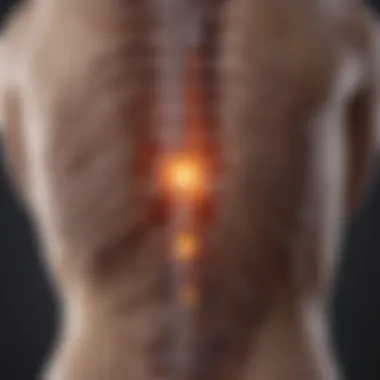Recognizing Symptoms of Spinal Meningioma


Intro
Spinal meningiomas are tumors that develop in the protective layers surrounding the spinal cord. While many tumors are benign, understanding the symptoms related to spinal meningiomas is essential for early detection. Many patients may experience varied signs, which can influence their quality of life significantly. Recognizing these symptoms can lead to timely medical intervention, which is crucial in managing this condition effectively.
The complexity of spinal meningioma symptoms arises from their location and the anatomical structures they affect. Symptoms can range from mild discomfort to severe neurological deficits, making a clear understanding of the indicators vital for healthcare practitioners, researchers, and affected individuals.
This article will explore the key symptoms associated with spinal meningiomas, along with the implications these symptoms have on diagnosis and treatment options. By delving into the varied presentations and their significance, we aim to provide a well-rounded perspective that aids in enhancing awareness and understanding of the topic.
Intro to Spinal Meningioma
Spinal meningiomas are a critical topic in neurology and oncology due to their potential impact on spinal health and patient quality of life. Understanding the nature of these tumors is essential to recognizing symptoms early and implementing effective management strategies. This introduction serves to highlight the significance of spinal meningiomas, exploring what they are, how they occur, and why awareness is vital for patients and healthcare providers alike.
These tumors originate from the meninges, the protective layers surrounding the spinal cord. They can vary in size and location, leading to different symptoms depending on their extensions and pressure exerted on nearby spinal structures. Without proper knowledge of the condition, individuals may experience delayed diagnoses, which can greatly influence treatment outcomes.
Patients diagnosed with spinal meningiomas may face various challenges, from physical discomfort to significant neurological impairments. Continued research is necessary not only to advance treatment protocols but also to refine diagnostic techniques which facilitate earlier detection. In this article, we will delve deeper into the essential aspects of spinal meningiomas and strive to provide a thorough understanding of their symptoms.
What are Spinal Meningiomas?
Spinal meningiomas are tumors that arise from the meninges. These tumors can be classified as benign or malignant. Most often, they are benign, meaning they do not typically invade surrounding tissues. This can provide some optimism regarding treatment options but does not reduce the seriousness of their effects on the patient.
Meningiomas can manifest at any level of the spinal column, including the cervical, thoracic, and lumbar regions. Depending on their location, the symptoms can vary significantly. As pressure mounts on the spinal cord and spinal nerves, a range of neurological symptoms can emerge.
It is important to recognize that even benign meningiomas can lead to significant issues due to their size or location. Early identification of spinal meningiomas is crucial for reducing long-term consequences and enhancing treatment options.
Prevalence and Demographics
Meningiomas are known to be one of the most common types of primary spinal tumors. They account for about 25-50% of all spinal tumors. The prevalence of spinal meningiomas tends to vary based on several factors including gender, age, and location.
Research shows that these tumors occur more frequently in women than in men. While the exact reasons for this difference remain unclear, hormonal influences may play a role in their development. The age group most affected ranges from 30 to 70 years, with a noticeable increase in incidence as individuals age.
Geographical variations also exist in the prevalence rates of spinal meningiomas. Certain populations may exhibit higher occurrences that could connect to genetic predispositions, although further studies are necessary to clarify these associations.
Understanding the demographics and prevalence helps in recognizing the risk factors associated with spinal meningiomas. This knowledge is crucial for proactive screening and potential preventive measures.
Understanding Symptoms of Spinal Meningioma
Spinal meningiomas can present with a variety of symptoms, underscoring the importance of recognizing these signs for timely diagnosis and management. Understanding the symptoms related to spinal meningiomas allows healthcare professionals, patients, and their families to identify potential issues quickly. Early intervention is crucial in minimizing complications that can arise as the tumor progresses.
The significance of understanding these symptoms extends beyond mere recognition; it provides insight into the potential evolution of the condition. Being informed can assist in making critical decisions about treatment options and lifestyle adjustments. Adequate knowledge empowers patients to communicate effectively with their medical teams, an essential aspect of personalized care.
Moreover, awareness of symptoms enhances quality of life. Patients who are vigilant about changes in their bodies can seek medical advice before symptoms worsen. This proactive approach can lead to better outcomes and improved overall wellbeing.
Common Symptoms
Common symptoms of spinal meningiomas often include:


- Localized Pain: Many patients experience persistent pain in the back or neck, which can vary in intensity. This pain might worsen with movement or prolonged periods of inactivity.
- Sensory Changes: Alterations in sensation, such as tingling or numbness, are frequently reported. This can occur in the arms, legs, or even across the torso.
- Weakness: A notable reduction in strength, especially in the arms or legs, can manifest. This weakness may seriously impact daily activities and mobility.
These symptoms are usually the first indicators that prompt patients to seek medical consultation. It is essential to monitor their severity and progression.
Less Common Symptoms
While some symptoms are characteristic of spinal meningiomas, others are less frequently observed but still noteworthy:
- Bowel and Bladder Dysfunction: Patients might notice difficulties with controlling bowel or bladder function, which may suggest that the tumor is affecting nearby nerves.
- Gait Issues: Some individuals may develop balance problems or a change in walking style, indicating potential neurological involvement.
- Severe Headaches: Unexplained headaches that do not respond to conventional pain relief methods may indicate increased intracranial pressure due to spinal issues.
Less common symptoms should not be dismissed. Even if they seem unrelated, these signs can provide valuable information regarding the tumor's impact on the central nervous system.
Symptom Progression
The progression of symptoms in spinal meningioma is not uniform for every patient. As the tumor grows, symptoms may evolve in nature and severity. Understanding this progression is vital:
- Early Stages: Initially, symptoms may be mild and intermittent. Patients often attribute these signs to stress or aging.
- Intermediate Stages: As the tumor increases in size, symptoms may become more persistent. Pain may escalate, and sensory disturbances can become more pronounced.
- Advanced Stages: Delayed intervention can lead to debilitating symptoms. More severe weakness, significant mobility issues, and heightened sensory deficits can occur.
"Understanding the signs of spinal meningiomas can pave the way for timely diagnosis and treatment, significantly enhancing patient outcomes."
Recognizing the progression can ultimately guide better management strategies and improve the individual’s overall quality of life. Patients and caregivers should remain vigilant, maintaining regular communication with healthcare providers regarding any changes in symptomatology.
Physical Symptoms
Physical symptoms associated with spinal meningiomas can significantly influence a patient's quality of life. Recognizing these symptoms is essential for timely intervention and management of the condition. Understanding the physical aspects allows both patients and healthcare providers to navigate the challenges that arise from this diagnosis effectively. It highlights the importance of monitoring and addressing these symptoms to prevent further complications.
Pain Management Concerns
Pain is often a primary concern for individuals suffering from spinal meningiomas. The location of the tumor can lead to localized or radiating pain, depending on the affected spinal segments. It is vital for patients to communicate their pain levels to their healthcare providers, as effective pain management can improve overall well-being and functionality.
Pain may arise from direct pressure on nerve roots or spinal structures, leading to discomfort that can be acute or chronic. Various pain relief options exist, including medication, physical therapy, or alternative treatments. Understanding the severity and character of the pain aids in tailoring an appropriate treatment plan. Consistent monitoring and adjustments in therapy can lead to better outcomes for patients.
Weakness and Numbness
Weakness and numbness are significant symptoms experienced by patients with spinal meningiomas. These sensations can indicate nerve involvement as a result of the tumor's growth. Weakness may present in the limbs, making daily activities challenging and affecting independence.
Numbness often accompanies weakness and may be a precursor to more severe neurological issues. Patients should consider documenting when these symptoms occur, as this information can assist medical professionals in making more informed decisions about the necessary diagnostic tests and treatment options. Immediate medical attention may be required if these symptoms exacerbate or progress rapidly.
Posture and Gait Changes
Changes in posture and gait often emerge as spinal meningiomas progress. As tumors grow and put pressure on critical areas of the spine, patients may begin to adopt compensatory postures to relieve discomfort. Over time, this can lead to abnormal gait patterns, increasing the risk of falls and other injuries.
It is important for individuals experiencing these changes to seek physiotherapy or rehabilitation services, which can help re-establish proper posture and gait mechanics. Early intervention may prevent long-term complications, promoting a better quality of life. Continued assessment of mobility and physical function is essential in managing these symptoms effectively.
Monitoring physical symptoms is crucial for early detection and intervention, leading to improved management of spinal meningiomas.
Neurological Symptoms


Neurological symptoms are critical in the understanding of spinal meningiomas. These symptoms arise from the interaction between the tumor and surrounding nerve structures, affecting the overall functionality and quality of life of the patient. Identifying these symptoms early can lead to appropriate interventions that may prevent further complications or deterioration of health. A focus on neurological symptoms provides insight into how spinal meningiomas may present themselves and the pathway to support those affected.
Motor Function Impairments
Motor function impairments are primarily concerned with a patient’s ability to control muscle movements. When spinal meningiomas exert pressure on specific regions of the spinal cord, they can disrupt the signals between the brain and the muscles. This can lead to symptoms such as weakness in the arms, legs, or trunk.
Patients might experience difficulty with everyday activities. Examples include climbing stairs, holding objects, or even walking. Often, these issues can progress gradually, making it harder for individuals to notice until a significant change occurs.
Incorporating rehabilitation efforts, such as physical therapy, may help manage these impairments. Strengthening exercises tailored to the specific weaknesses can be beneficial. Regular monitoring through neurological assessments can aid in tracking the progression of these symptoms.
Sensory Disturbances
Sensory disturbances refer to changes or loss of sensation. Individuals might experience tingling, numbness, or altered pain perception. These sensations result from the compression of nerves affected by the growing meningioma. A common area affected is the legs, where patients might feel a pins-and-needles sensation.
These discomforts can lead to an increased risk of falls and injuries. Living with sensory disturbances can be challenging, as the unpredictability of these symptoms can impact daily activities.
It is critical for healthcare providers to evaluate sensory symptoms carefully. This assessment can guide effective treatment plans aimed at alleviating discomfort and improving sensory function.
Cognitive and Emotional Impact
Cognitive and emotional impacts of spinal meningiomas tend to be less visible but are profoundly significant. Patients may experience mood swings, depression, or anxiety as they wrestle with the diagnosis and its implications. Cognitive functions, such as memory and focus, could also suffer, affected by both the physical presence of the tumor and the emotional burden of coping with a chronic condition.
Social interactions may become strained due to alterations in cognitive function or emotional state. The stigma surrounding neurological conditions adds another layer of complexity. Understanding these aspects is essential for caregivers and health professionals to provide comprehensive support to individuals with spinal meningiomas.
"The influence of neurological symptoms extends beyond physical challenges, impacting emotional well-being and social dynamics."
Addressing both the physical and emotional aspects is vital in treatment plans, ensuring a holistic approach to patient care.
Overall, exploring neurological symptoms associated with spinal meningiomas gives a clearer understanding of how these tumors affect daily life. Appropriate recognition of these symptoms allows for timely interventions, which can significantly enhance the quality of life for affected individuals.
Diagnostic Procedures
Diagnostic procedures play a crucial role in understanding spinal meningiomas. Identifying the presence of these tumors requires precise techniques that assist in differentiating them from other spinal conditions. Effective diagnostic methods not only confirm the diagnosis but also guide treatment decisions. Accurate recognition of symptoms often leads to timely interventions, thus improving patient outcomes.
Imaging Techniques for Diagnosis
Imaging techniques are the backbone of diagnosing spinal meningiomas. Common modalities include Magnetic Resonance Imaging (MRI) and Computed Tomography (CT) scans.
- MRI is often the preferred method. It provides detailed images of both the soft tissues and the spinal cord, allowing for accurate visualization of the tumor's size, location, and impact on surrounding structures.
- CT scans can also be helpful, especially when MRI is not available or when assessing bone involvement. They are less sensitive than MRIs but can provide useful information in certain scenarios.
These imaging techniques help in detecting lesions that may not be visible during a physical examination. Furthermore, advanced imaging techniques, like diffusion-weighted imaging and contrast-enhanced MRI, can help characterize the tumor and assess its biological behavior.
Neurological Evaluation
Neurological evaluation involves a series of clinical assessments to gauge the patient's neurological function. This assessment complements imaging studies by providing insights into the degree of impairment due to the spinal meningioma. During an evaluation, a healthcare professional will assess:


- Motor Skills: This includes testing strength and coordination, which can be affected by tumor pressure on the spinal cord.
- Sensation: The ability to feel touch, pain, and temperature will be assessed across various parts of the body to identify specific nerve involvement.
- Reflexes: Alterations in reflexes can indicate nerve dysfunction or irritation caused by the tumor.
Neurological evaluations are vital. They provide baseline data for monitoring disease progression and treatment response. Regular follow-ups can assist healthcare providers in adjusting treatments as needed.
Accurate diagnostic procedures form the foundation of effective management for spinal meningiomas, leading to better health outcomes and enhanced quality of life for patients.
In summary, the merging of advanced imaging techniques and thorough neurological examinations offers a comprehensive view of spinal meningiomas. Monitoring these diagnostic elements is essential in managing symptoms and improving patient care.
Quality of Life Considerations
Understanding the quality of life considerations when dealing with spinal meningiomas is crucial. These tumors, while often benign, can severely impact daily functioning and emotional well-being. Quality of life encompasses various aspects including physical health, mental health, and social interactions. Addressing these concerns can significantly enhance patient experience and outcomes.
Impact of Symptoms on Daily Living
Symptoms resulting from spinal meningiomas can manifest in diverse ways, affecting daily living. Physical symptoms such as pain, weakness, and numbness can limit activities. For instance, patients may find it difficult to perform simple tasks like dressing or cooking. The unpredictability of symptoms can lead to a cycle of anxiety and frustration.
Daily routines may require adaption. People with compromised mobility could need assistance with transportation or even personal care. This dependency can diminish self-esteem and lead to feelings of helplessness. Maintaining independence is often a priority, so promoting strategies for symptom management is essential.
Here are some impacts that symptoms can have on daily living:
- Physical limitations: Difficulty in standing, walking, and maintaining posture.
- Fatigue: Persistent tiredness that affects energy levels for daily tasks.
- Sleep disturbances: Pain and discomfort, which can disrupt sleep patterns.
- Social withdrawal: Avoiding activities due to embarrassment or discomfort.
Psychosocial Aspects
Psychosocial aspects play a significant role in the quality of life for patients with spinal meningiomas. The diagnosis of any tumor often brings emotional challenges. Feelings of fear, uncertainty, and isolation emerge as the reality of living with a chronic condition sets in.
Support systems, such as family and friends, become vital for mental health stability. Open discussions about feelings and experiences with loved ones can foster an environment of support. Additionally, seeking professional help through counseling can provide coping strategies to handle emotional distress.
Important considerations related to psychosocial aspects include:
- Fear of progression: Anxiety about the possibility of growth or recurrence of the tumor.
- Social support: Importance of having a network that understands and offers assistance.
- Adaptation strategies: Learning ways to cope with emotional and psychological stress.
"Managing both the physical and emotional aspects of spinal meningiomas is essential for enhancing overall quality of life."
The End
Understanding the symptoms of spinal meningioma is crucial for effective health management and early diagnosis. This article has outlined various symptoms associated with spinal meningiomas and their impact on patient quality of life. Recognizing these symptoms can lead individuals to seek timely medical advice, which may facilitate better treatment options.
Summary of Key Symptoms
Spinal meningioma symptoms can vary in severity and can manifest in numerous ways. Key symptoms to be aware of include:
- Pain in the back or neck: This is often persistent and can significantly affect daily activities.
- Weakness or numbness: Patients may experience localized weakness or reduced sensation in limbs.
- Changes in posture: Difficulty with balance and coordination can occur, leading to abnormal gaits.
It's important for individuals experiencing these symptoms to consult a healthcare provider.
Through awareness, patients can advocate for themselves and ensure they receive comprehensive evaluations.
Future Perspectives on Symptom Management
Advancements in medical technology and research provide promising avenues for managing the symptoms of spinal meningiomas. Future perspectives indicate a growing emphasis on personalized treatment approaches, integrating:
- Precision medicine: Tailoring treatment plans based on individual genetic and molecular profiles may improve outcomes.
- Multidisciplinary teams: Collaboration between neurosurgeons, oncologists, and rehabilitation specialists can enhance patient care.
- Enhanced imaging technologies: Improvements in imaging can lead to earlier detection and more effective monitoring of tumor progression.







